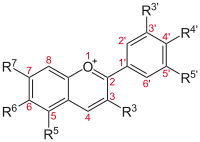
3-Deoxyanthocyanidin
Encyclopedia

Anthocyanidin
Anthocyanidins are common plant pigments. They are the sugar-free counterparts of anthocyanins based on the flavylium ion or 2-phenylchromenylium, which is a type of oxonium ion . They form a large group of polymethine dye. In particular anthocyanidins are salt derivatives of the...
s backbone lacking an hydroxyl group on carbon 3.
3-Deoxyanthocyanidins are yellow
Yellow
Yellow is the color evoked by light that stimulates both the L and M cone cells of the retina about equally, with no significant stimulation of the S cone cells. Light with a wavelength of 570–590 nm is yellow, as is light with a suitable mixture of red and green...
anthocyanidins that can be found primarily in ferns and mosses (Timberlake and Bridle, 1975, 1980), in Sorghum bicolor
Sorghum bicolor
Sorghum bicolor, commonly called sorghum and also known as durra or jowari, is a grass species cultivated for its edible grain. Sorghum originated in northern Africa, and is now cultivated widely in tropical and subtropical regions. S. bicolor is typically an annual, but some cultivars are...
and in purple corn (Nakatani et al., 1979) (maíz morado).
3-Deoxyanthocyanidins are reported to be stable to color loss due to change in pH. Synthetic 3-deoxyanthocyanidins with a carboxylate group at carbon 4 show unusually stable colorant
Food coloring
Food coloring is a substance, liquid or powder, that is added to food or drink to change its color. Food coloring is used both in commercial food production and in domestic cooking...
properties at pH 7.
In Sorghum, the SbF3'H2 gene, encoding a flavonoid 3'-hydroxylase, seems to be expressed in pathogen-specific 3-deoxyanthocyanidin phytoalexin
Phytoalexin
Phytoalexins are antimicrobial substances synthesized de novo by plants that accumulate rapidly at areas of incompatible pathogen infection. They are broad spectrum inhibitors and are chemically diverse with different types characteristic of particular plant species...
s synthesis, for example in Sorghum-Colletotrichum
Colletotrichum
Colletotrichum is a genus of fungi that are obligate symbionts to plants in the form of endophytes. Many of the species in this genus are plant pathogens, although some species may express a mutualistic life-style in non-disease hosts....
interactions.
This category include :
- ApigeninidinApigeninidinApigeninidin is a chemical compound belonging to the 3-deoxyanthocyanidins and that can be found in the Patagonian plant Ephedra frustillata and in the soybean. Projects in Burkina Faso have been led in 1994 to use a red desoxy-3-anthocyanin pigment identified as apigenidin from Sorghum in the...
- ColumnidinColumnidinColumnidin is an orange red pigment, belonging to the 3-deoxyanthocyanidins found in red-flowered western-hemisphere gesneriad species such as episcias, columneas, sarmientas, and sinningias....
- DiosmetinidinDiosmetinidinDiosmetinidin is a 3-deoxyanthocyanidin.-External links:*...
- LuteolinidinLuteolinidinLuteolinidin is a chemical compound belonging to the 3-deoxyanthocyanidins and that can be found in Sorghum bicolor.-Glycosides:Luteolinidin 5-O-β-D-[3-O-β-D-glucopyranosyl-2-O-acetylglucopyranoside] Luteolinidin is a chemical compound belonging to the 3-deoxyanthocyanidins and that can be found in...
- TricetinidinTricetinidinTricetinidin is a intense red-colored chemical compound belonging to the 3-deoxyanthocyanidins. It can be found in black tea infusions. Tricetinidin, in tea, would be a product of the oxidative degallation of epigallocatechin gallate ....

